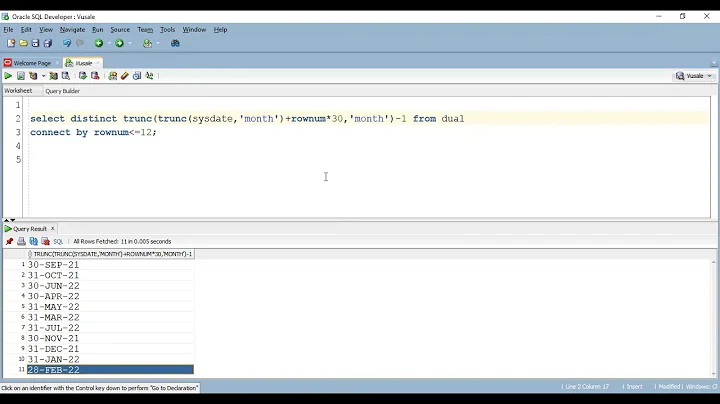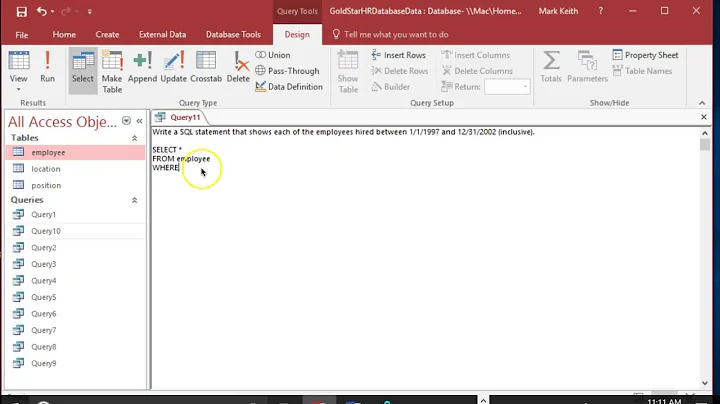Interesting SQL Join on dates between dates
Solution 1
You'll need either a Calendar table or you can generate one with a CTE. Once you have that, the rest of the query should be fairly trivial. The CTE approach can be a little complex due to recursion issues and not being allowed to use aggregates, so below I've used a table variable. You can also make this a permanent table that you keep in your database.
SET NOCOUNT ON
DECLARE @Calendar TABLE (my_date DATETIME NOT NULL)
DECLARE @date DATETIME, @max_date DATETIME
SELECT @date = MIN(StartDate), @max_date = MAX(EndDate) FROM My_Table
WHILE (@date <= @max_date)
BEGIN
INSERT INTO @Calendar (my_date) VALUES (@date)
SELECT @date = DATEADD(dy, 1, @date)
END
SELECT
C.myDate,
M.RequestType,
M.Area,
COUNT(*) AS myCount
FROM
@Calendar C
INNER JOIN My_Table M ON
M.StartDate <= C.myDate AND
M.EndDate >= C.myDate
GROUP BY
C.myDate,
M.RequestType,
M.Area
ORDER BY
C.myDate,
M.RequestType,
M.Area
Depending on how large your potential date range is, filling the table variable could take awhile. For example, if the range spanned a decade or two.
Solution 2
Sounds like you may want a 'Calendar' file. Especially as part of a larger business organization, this will become extremely useful.
After generating the calendar, you can get your table with the following:
SELECT a.isoDate, b.RequestType, b.Area, count(*)
FROM calendar as a
JOIN mySPTable as b
ON a.isoDate between b.StartDate and b.EndDate
WHERE a.isoDate >= [input_start_date]
AND a.isoDate < [input_end_date]
GROUP BY a.isoDate, b.RequestType, b.Area
This will generate a row for every date in the calendar file that is between the start and end dates for at least one row of mySPTable.
As a side note, it's also possible to generate the range of dates with a recursive CTE, but especially over the long run, I'd recommend generating and using the calendar file.
Quick CTE:
WITH DateRange (thisDate) as (SELECT [input_start_date]
UNION ALL
SELECT DATEADD(dy, 1, thisDate)
FROM DateRange
WHERE thisDate < [input_end_date])
Solution 3
You can do this with a number table (starting from 0). Here I use master..spt_values instead. SQL, Auxiliary table of numbers
select dateadd(day, N.Number, M.StartDate) as myDate,
RequestType,
Area,
count(*) as myCount
from mySPtable as M
inner join master..spt_values as N
on N.Number <= datediff(day, M.StartDate, M.EndDate)
where N.type = 'P'
group by dateadd(day, N.Number, M.StartDate),
RequestType,
Area
order by dateadd(day, N.Number, M.StartDate)
Related videos on Youtube
CodingIsAwesome
Updated on July 09, 2022Comments
-
CodingIsAwesome almost 2 years
First off, thanks to anyone who helps me solve this problem. I am using SQL 2005, but can use 2008 if no solution is available in 05.
I have a rows of data that look like such:
select * from mySPtable | myPK | Area | RequestType | StartDate | EndDate | 1 SB ADD 8/14/2011 8/18/2011 2 NB RMV 8/16/2011 8/16/2011So what I want to do is count up the total requests for each area by day. Results should be:
| myDate | RequestType | Area | myCount | 8/14/2011 ADD SB 1 8/15/2011 ADD SB 1 8/16/2011 ADD SB 1 8/16/2011 RMV NB 1 8/17/2011 ADD SB 1 8/18/2011 ADD SB 1How do I go about doing this? I'm stumped and no amount of googling has helped.
-
Jim Garrison almost 13 yearsDoes the first row (myPK == 1) imply a total of five requests, one per day?
-
-
 Cygnusx1 almost 13 yearswould adding a table with all the dates not be easier and faster? instead of creating it at runtime? btw nice solution...
Cygnusx1 almost 13 yearswould adding a table with all the dates not be easier and faster? instead of creating it at runtime? btw nice solution... -
Tom H almost 13 yearsThat's how I would normally do it, and I did mention that you could make it a permanent table. I usually have a Calendar in my databases where I can also include things like is_holiday, is_weekday, financial_quarter, etc. to make a lot of queries easier.
-
HABO almost 13 yearsI'm a fan of CTEs, but be aware there is a limit on the number of recursions. The absolute limit is 32,767 and the default limit is 100. See MAXRECURSION at msdn.microsoft.com/en-us/library/ms175972.aspx.
-
 Clockwork-Muse over 12 yearsI keep forgetting that SQL Server has that default - DB2 doesn't, and I think the limit is getting an out-of-memory error. Of course, if you're running over more than about a year's worth of dates, you probably want an actual calendar file anyways...
Clockwork-Muse over 12 yearsI keep forgetting that SQL Server has that default - DB2 doesn't, and I think the limit is getting an out-of-memory error. Of course, if you're running over more than about a year's worth of dates, you probably want an actual calendar file anyways... -
HABO over 12 yearsCorrection: Setting MAXRECURSION to zero disables any limit. My bad.
-
Steve McCall over 9 yearsI found this very helpful for something related that I was stuck on!






